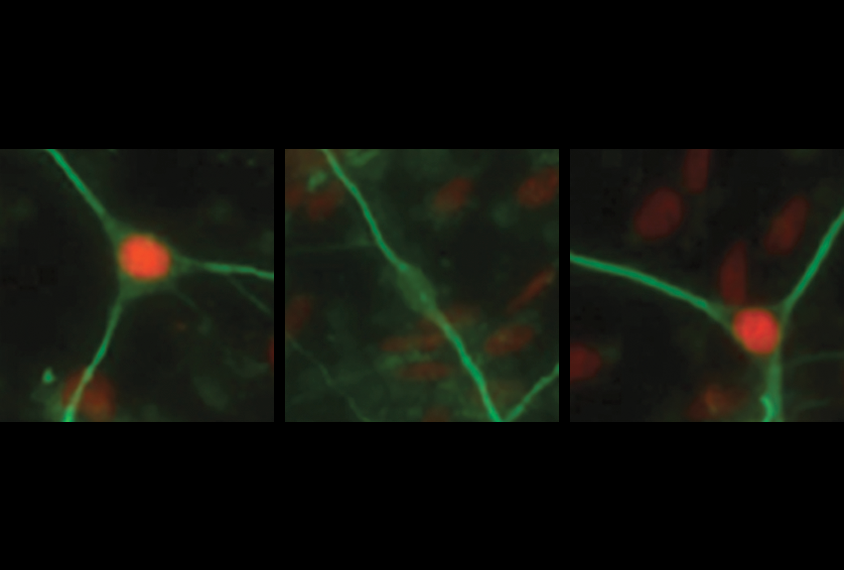A combination of modified CRISPR tools can dial up the expression of MECP2, the gene mutated in Rett syndrome, without changing the gene itself, a new study of human neurons finds.
The approach acts on epigenetic factors that silence one copy of the gene in people with the condition, which is characterized by autism-like traits, including repetitive movements, impaired motor coordination and social withdrawal. Reactivating the gene may counteract the effects of MECP2 mutations, offering hope for a new treatment approach.
“This is an outstanding example of epigenome engineering’s potential as a future gene therapy,” says Stanley Qi, associate professor of bioengineering at Stanford University in California, who was not involved in the study. “Changing information on the epigenome rather than the genome avoids altering our genetic codes.”
Because MECP2 resides on the X chromosome, mutations in the gene are usually fatal in male infants, who lack a backup copy. A process called X-chromosome inactivation randomly turns off one of the two copies female babies carry, so mutations leave about half of their neurons without any functional MECP2 protein, leading to the syndrome’s core traits.
X-chromosome inactivation occurs when methyl groups and small pieces of RNA coat the chromosome and block its expression. Molecules that prevent this coating can reawaken the silent version of MECP2, previous research shows, but can rouse other silenced genes too.
“For years I had seen researchers try to reactivate MECP2 on the inactive X using a variety of approaches, but usually only achieving a very minimal amount of MECP2 activation, or activation that too broadly affected other genes,” says Lisa Boxer, investigator at the National Cancer Institute’s Center for Cancer Research in Bethesda, Maryland.
I
n the new work, researchers used a CRISPR-based strategy to guide a methyl-removing enzyme straight to the MECP2 gene, building on a strategy they had previously used to restore the expression of the gene involved in fragile X syndrome — another X-linked condition and a leading cause of autism.“We thought we could try to tackle another neurodevelopmental disorder,” says lead investigator Shawn Liu, assistant professor of physiology and cellular biophysics at Columbia University. Compared with fragile X syndrome, Rett syndrome has a “pretty complicated X chromosome inactivation mechanism to ensure complete silencing of the X chromosome, so technically it’s more challenging.”
Removing methyl groups from the silent MECP2 copy increased the gene’s expression in female human embryonic stem cells that carry a MECP2 mutation on one chromosome, the team found. The changes persisted in neurons derived from those methylation-edited stem cells, and the neurons grew larger cell bodies and fired more frequently than Rett-like neurons derived from unedited stem cells.
But methylation editing was less effective when the team applied it directly to Rett-like neurons.
So Liu’s team harnessed a trick that certain genes use to avoid X-chromosome inactivation: CTCF insulation. Binding a protein called CTCF to certain stretches of DNA protects those regions from epigenetic regulation.
Using another modified form of CRISPR to deliver CTCF proteins to binding sites the team discovered on the MECP2 gene, in combination with DNA methylation editing, successfully increased MECP2 transcription in Rett-like neurons, the researchers found. This mix also reversed typical Rett syndrome neuronal defects, including smaller cell bodies and atypical electrical activity. The results appeared in January in Science Translational Medicine.
“The one key lesson we learned is that it seems that methylation editing is essential, no matter what you combine it with,” Liu says. “If you don’t have methylation editing, once the gene is completely silenced, there’s no way to reactivate it.”
N
ext, the team plans to investigate this combination of epigenomic editing in mouse models of Rett syndrome and dive into exactly how methylation editing triggers MECP2 recovery.“We are really curious to apply the same editing strategy in vivo using a Rett syndrome mouse model … and we have no idea whether this will work,” Liu says. “If so, I think it’s quite exciting not only for basic scientists and the rare syndrome family but also for clinical studies.”
Testing this technique in mouse models will help determine whether these epigenomic editors can be delivered to the brain and whether MECP2 can be reactivated enough in mature neurons to affect behavior, Boxer says.
The epigenome editors the team used are too large to fit into the viral vectors commonly used for gene therapies, Liu says.
“I hope our study could help [other researchers] come up with more new ways to tackle X-linked disease or other inheritable disorders, by precisely manipulating genes that cause disorders,” adds study investigator Junming Qian, a graduate student in Liu’s lab. “Also, we have made our tool available and hope our tools can be used in both basic and clinical research.”





